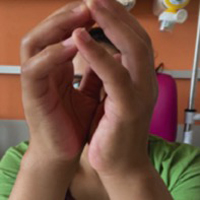The place of 18F FDG PET/CT in the management of patients with eosinophilic fasciitis: a case report

Submitted: 17 September 2020
Accepted: 4 November 2020
Published: 18 January 2021
Accepted: 4 November 2020
Abstract Views: 822
PDF: 501
Publisher's note
All claims expressed in this article are solely those of the authors and do not necessarily represent those of their affiliated organizations, or those of the publisher, the editors and the reviewers. Any product that may be evaluated in this article or claim that may be made by its manufacturer is not guaranteed or endorsed by the publisher.
All claims expressed in this article are solely those of the authors and do not necessarily represent those of their affiliated organizations, or those of the publisher, the editors and the reviewers. Any product that may be evaluated in this article or claim that may be made by its manufacturer is not guaranteed or endorsed by the publisher.
Similar Articles
- L. Magnani, A. Versari, D. Salvo, M. Casali, G. Germanò, R. Meliconi, L. Pulsatelli, D. Formisano, G. Bajocchi, N. Pipitone, L. Boiardi, C. Salvarani, Disease activity assessment in large vessel vasculitis , Reumatismo: Vol. 63 No. 2 (2011)
- A.M. Treichel, D.X. Zheng, G.C. Ranasinghe, A.S. Zeft, W.F. Bergfeld, C.B. Bayart, Eosinophilic fasciitis in a young male auto mechanic exposed to organic solvents , Reumatismo: Vol. 75 No. 3 (2023)
- N. Romano, A. Fischetti, V. Prono, S. Migone, F. Barbieri, C. Pizzorni, G. Garlaschi, M.A. Cimmino, Plantar pain is not always fasciitis , Reumatismo: Vol. 69 No. 4 (2017)
- M. Skoczynska, F. Figus, V. Arena, G. Massazza, A. Iagnocco, The role of PET in a clinically silent and ultrasound negative synovitis in the course of rheumatoid arthritis - a case report , Reumatismo: Vol. 73 No. 1 (2021)
- N. Belfeki, E. Gharbi, C. Flateau, S. Diamantis, Erysipelas-like presentation of Wells’ syndrome (eosinophilic cellulitis) , Reumatismo: Vol. 71 No. 4 (2019)
- N. Possemato, C. Salvarani, N. Pipitone, Imaging in polymyalgia rheumatica , Reumatismo: Vol. 70 No. 1 (2018): Monographic issue on Polymyalgia Rheumatica
- B. Cremonezi Lammoglia, L. de Aguiar Trevise, T. Paslar Leal, M. Pereira Lopes Vieira Pinto, G. Hasselmann, N. Salles Rosa Neto, Eosinophilic granulomatosis with polyangiitis: sequential use of mepolizumab following rituximab for inadequate asthma control despite vasculitis remission , Reumatismo: Vol. 75 No. 4 (2023)
- M. Bruschi, F. De Leonardis, M. Govoni, M. Roncali, N. Prandini, R. La Corte, L. Feggi, F. Trotta, 18FDG-PET and large vessel vasculitis: preliminary data on 25 patients , Reumatismo: Vol. 60 No. 3 (2008)
- R. Foti, R. Leonardi, G. Fichera, M. Di Gangi, C. Leonetti, P. Gangemi, R. De Pasquale, Buschke Scleredema, case report , Reumatismo: Vol. 58 No. 4 (2006)
- S. Scriffignano, F.M. Perrotta, M. Ricci, B. Carabellese, E. Lubrano , Visceral muscle dysmotility syndrome in systemic lupus erythematosus: which is the role of 18 fluorodeoxyglucose-positron emission tomography-computed tomography? A clinical case and literature review , Reumatismo: Early Access
You may also start an advanced similarity search for this article.

 https://doi.org/10.4081/reumatismo.2020.1353
https://doi.org/10.4081/reumatismo.2020.1353




